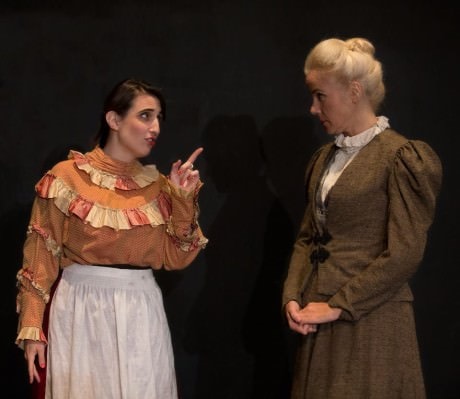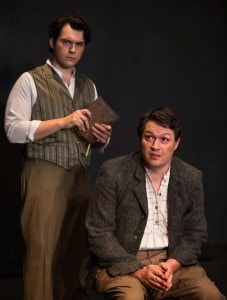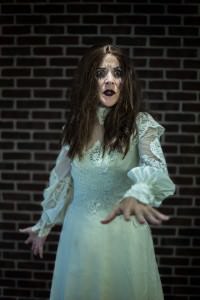Contrary to popular belief, the Grand Guignol theatre did not rely exclusively on blood and gore to convey horror. The psychological element was equally important to the genre, and horrific events often were showcased with nary a drop of blood spilled.

That idea is central to Molotov Theatre Group’s production of Lovecraft: Nightmare Suite, adapted by Dan Spurgeon from the works of H.P. Lovecraft.

This new production from Molotov uses one of the classic stylistic elements of the Grand Guignol – fourth wall ambiguity – to create a creeping voyeuristic sense of dread among audience members.
It’s a nod to one of the earliest of Grand Guignol plays, Au Téléphone, by the legendary Andrés de Lorde. In the 1902 script, a man who has just made a purchase of the expensive new-fangled “telephone,” is forced to witness the death of his wife by hearing the event over the contraption. The horror of the moment is captured on the man’s face as he looks through the audience into the distance, seeing the events unfold in his mind’s eye. It is exactly what he is not seeing that causes him – and the audience – the greatest distress.
Throughout Lovecraft: Nightmare Suite, Director Jay D. Brock (who directed Molotov’s Helen Hayes Awards© Recommended Normal), has his cast take their moments of horror directly to the audience. This is particularly true in the show’s opening story, “The Statement of Randolph Carter,” which in many ways parallels the technological setup of Au Téléphone.
The true-to-the-genre convention makes the cast and the audience unwilling participants in the grim proceedings. And that notion of playing up and out to the audience is echoed throughout the inventive staging of Lovecraft: Nightmare Suite. This is a particularly effective approach to a show that also has its roots in reader’s theatre. The evening is a theatrically realized series of chilling campfire stories, complemented by ambitious projections, evocative costumes and compelling original musical composition.

Joining Brock in bringing Lovecraft: Nightmare Suite to life is composer Gregory Thomas Martin, who also was part of the team for Molotov’s critically acclaimed “Normal.” Projection design and set construction by Rachel Marie Wallace, lighting by Leigh Mumford, properties by Katherine Offutt, costume design by Jesse Shipley and makeup design by Elena Porres round out the sophisticated elements that bring a slightly Steampunk feeling of American Victorian fashion (and creepiness) to the stage.
The cast features Molotov stalwarts Elizabeth Darby, Elliott Kashner, Brian McDermott, and yours truly. New to Molotov for this production is Jennifer Restak.
As a spooky Halloween treat, Lovecraft: Nightmare Suite delivers chills for horror fans of all ages, from the youngest wide-eyed Chthulu kids to the most jaded cosmic Elders. We welcome all to try to catch a glimpse of what’s not being seen this month.
Lovecraft: Nightmare Suite plays from October 15-November 14, 2015 at 7:30 pm at The DC Arts Center (DCAC) – 2438 18th Street, NW, in Washington, DC 20009, in Adams Morgan.
Purchase tickets online.
Complimentary beer will be provided before and after opening night’s performance by Raven Beer of Baltimore.


![Lovecraft Ad 728x90[1]](https://dctheaterarts.org/wp-content/uploads/2015/08/Lovecraft-Ad-728x901.jpg)


